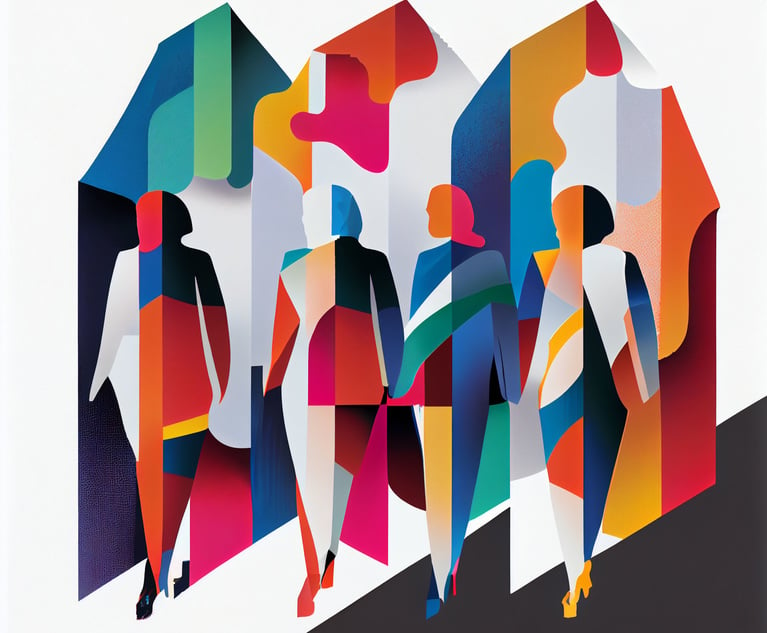On Appeals: The Surprising Humanity of Remote Work
We talk a lot about when things might "return to normal." In the context of law practice, it may be worth asking whether they should.
July 24, 2020 at 07:40 PM
6 minute read
 Susan Yorke, California Appellate Law Group. (Courtesy photo)
Susan Yorke, California Appellate Law Group. (Courtesy photo)
Law is a famously formal profession. That formality is enshrined in all sorts of ways—special titles for attorneys and judges, strict dress codes in the office and in court, ritualized oaths and cries, the banging of the gavel. At a time when first names, ping pong tables, and hoodies are de rigueur in most other professions, the law is strikingly anachronistic.
Before COVID-19, the legal profession as a whole did not appear to be in any hurry to catch up. In many ways, that makes perfect sense. Large law firms have rigid structures that make them slow to embrace new ways of working. And the law itself derives respect in part from the performance of ritual. Hushed courtrooms reflect the gravity of the difficult work that's done inside those walls, and formalities preserve the institutional identities of advocates and judges.
A small handful of firms did embrace more flexible approaches to work early on. My firm, the California Appellate Law Group, is one of those few, so I've been privileged to work remotely for the past several years. This has afforded me significant freedom, both in managing my day-to-day life and in getting to see more of the world (I'm writing this from Japan!).
But the pandemic marks the first time that remote work has been systemwide. Now opposing counsel, clients and judges are all appearing from home. And that's provided an opportunity to think about new ways of doing legal work and gain insight into some of the legal traditions that perhaps no longer serve us.
Many of the formalities of legal practice serve to obscure the individuality of actors within the system. This is intentional—legal disputes are not supposed to be about the lawyers or judges who help resolve them. But the impersonal nature of many interactions—combined with the significant pressures of the profession—can create an ethos that discourages participation, devalues empathy, and perpetuates entrenched hierarchies.
The pandemic has broken down some of those formalities. To be sure, remote meetings, hearings and arguments have their foibles. Toilets are flushed at historic and inopportune times. Sound quality may be poor, and visual cues may be harder to read. It can be difficult to know when to start talking and when to stop. There may be privacy concerns, embarrassing gaffes, and technological impediments.
But remote work has also offered us a window into our professional colleagues' lives. We see now that opposing counsel has a young child to care for, or that our quiet co-worker has a quirky and expressive interior decorating style. The guitar leaning against the living room wall or the unruly pet bounding into view show us aspects of each other that we might not discover in a traditional office setting. These snapshots of life serve as a reminder that each of us is a multifaceted person, with an identity and a set of concerns and interests outside of our existence as a lawyer.
Remote appellate arguments, in particular, may have some surprising advantages in terms of reflecting our shared humanity. The design of the physical courtroom is intended to create a sense of solemnity, formality, and hierarchy. Judges are elevated above counsel and the public, placed at a distance from the lectern and audience. Counsel tables are on opposite sides of the room in front of the gallery. Appellate practitioners are constantly advised to maintain a conversational tone during argument, but how often do you have a casual conversation with someone who's 15 feet away and 5 feet above you, while a gaggle of onlookers watch you from behind?
In a video argument, the judges don't loom from the bench. Remote meeting technology is a great equalizer—we're all just boxes on a screen. For new attorneys or those prone to stage fright, remote arguments may encourage participation and help foster the natural dynamic that judges and advocates prefer. Indeed, the video arguments I've seen over the past few months have—technological hiccups aside—tended to be more conversational in tone.
Of course, advocates should continue to maintain some level of formality. Wear a suit (top and bottom!), use a non-distracting background, address judges by their titles, and don't interrupt. Still, a remote argument really can feel more like a conversation (after all, we chat with our friends on Zoom all the time now), and that helps judges get the information they need to decide their cases.
Remote arguments also decrease the price of the proverbial "day in court." For far-flung clients, having the option of a video argument can make a real financial difference. And for public-sector or nonprofit attorneys with limited budgets, eliminating the burden of travel saves time and money and may allow more lawyers to participate in arguments.
We talk a lot about when things might "return to normal." In the context of law practice, it may be worth asking whether they should. Having the option to work remotely affords lawyers greater flexibility and more time with their families. Holding oral arguments by video reduces travel costs for courts and clients alike and may well encourage broader participation by a younger and more diverse set of attorneys. These benefits are worth taking into account.
But even if things do return to normal, we'd be wise to take some of the lessons from the pandemic with us. Our colleagues, judges and opposing counsel are all people, with boisterous kids and noisy puppies and messy homes. If we gain one professional insight from the experience of COVID-19, I hope it's that we can zealously represent our clients while holding space for the humanity of our fellow lawyers.
On Appeals is a monthly column by the attorneys of the California Appellate Law Group, an appellate boutique with offices in San Francisco, Los Angeles and San Diego. Susan Yorke is of counsel with the firm. She served as a law clerk on the Ninth Circuit for two judges and in the Appellate Division of the Oregon Department of Justice. Find out more about Yorke and the California Appellate Law Group at www.calapplaw.com.
This content has been archived. It is available through our partners, LexisNexis® and Bloomberg Law.
To view this content, please continue to their sites.
Not a Lexis Subscriber?
Subscribe Now
Not a Bloomberg Law Subscriber?
Subscribe Now
NOT FOR REPRINT
© 2025 ALM Global, LLC, All Rights Reserved. Request academic re-use from www.copyright.com. All other uses, submit a request to [email protected]. For more information visit Asset & Logo Licensing.
You Might Like
View All
ABC's $16M Settlement With Trump Sets Bad Precedent in Uncertain Times
8 minute read


Trending Stories
Who Got The Work
J. Brugh Lower of Gibbons has entered an appearance for industrial equipment supplier Devco Corporation in a pending trademark infringement lawsuit. The suit, accusing the defendant of selling knock-off Graco products, was filed Dec. 18 in New Jersey District Court by Rivkin Radler on behalf of Graco Inc. and Graco Minnesota. The case, assigned to U.S. District Judge Zahid N. Quraishi, is 3:24-cv-11294, Graco Inc. et al v. Devco Corporation.
Who Got The Work
Rebecca Maller-Stein and Kent A. Yalowitz of Arnold & Porter Kaye Scholer have entered their appearances for Hanaco Venture Capital and its executives, Lior Prosor and David Frankel, in a pending securities lawsuit. The action, filed on Dec. 24 in New York Southern District Court by Zell, Aron & Co. on behalf of Goldeneye Advisors, accuses the defendants of negligently and fraudulently managing the plaintiff's $1 million investment. The case, assigned to U.S. District Judge Vernon S. Broderick, is 1:24-cv-09918, Goldeneye Advisors, LLC v. Hanaco Venture Capital, Ltd. et al.
Who Got The Work
Attorneys from A&O Shearman has stepped in as defense counsel for Toronto-Dominion Bank and other defendants in a pending securities class action. The suit, filed Dec. 11 in New York Southern District Court by Bleichmar Fonti & Auld, accuses the defendants of concealing the bank's 'pervasive' deficiencies in regards to its compliance with the Bank Secrecy Act and the quality of its anti-money laundering controls. The case, assigned to U.S. District Judge Arun Subramanian, is 1:24-cv-09445, Gonzalez v. The Toronto-Dominion Bank et al.
Who Got The Work
Crown Castle International, a Pennsylvania company providing shared communications infrastructure, has turned to Luke D. Wolf of Gordon Rees Scully Mansukhani to fend off a pending breach-of-contract lawsuit. The court action, filed Nov. 25 in Michigan Eastern District Court by Hooper Hathaway PC on behalf of The Town Residences LLC, accuses Crown Castle of failing to transfer approximately $30,000 in utility payments from T-Mobile in breach of a roof-top lease and assignment agreement. The case, assigned to U.S. District Judge Susan K. Declercq, is 2:24-cv-13131, The Town Residences LLC v. T-Mobile US, Inc. et al.
Who Got The Work
Wilfred P. Coronato and Daniel M. Schwartz of McCarter & English have stepped in as defense counsel to Electrolux Home Products Inc. in a pending product liability lawsuit. The court action, filed Nov. 26 in New York Eastern District Court by Poulos Lopiccolo PC and Nagel Rice LLP on behalf of David Stern, alleges that the defendant's refrigerators’ drawers and shelving repeatedly break and fall apart within months after purchase. The case, assigned to U.S. District Judge Joan M. Azrack, is 2:24-cv-08204, Stern v. Electrolux Home Products, Inc.
Featured Firms
Law Offices of Gary Martin Hays & Associates, P.C.
(470) 294-1674
Law Offices of Mark E. Salomone
(857) 444-6468
Smith & Hassler
(713) 739-1250






